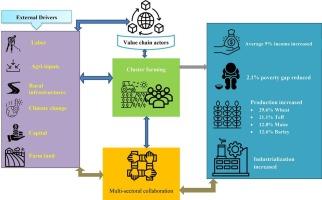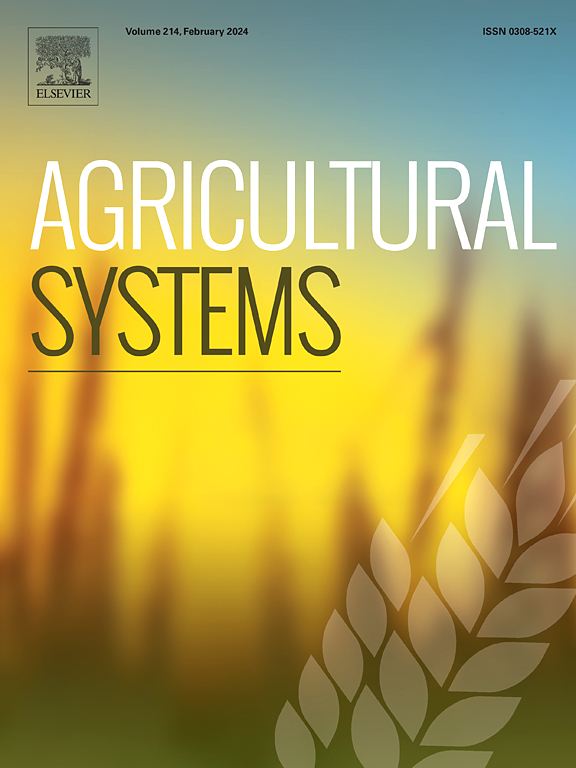Contribution of cluster farming to household economy in Ethiopia: A systematic review
IF 6.1
1区 农林科学
Q1 AGRICULTURE, MULTIDISCIPLINARY
引用次数: 0
Abstract
Context
Cluster farming is a new approach that began in Ethiopia in 2015 to shift smallholder farmers' production from subsistence to a commercial system. Improving income, increasing exports, ensuring food quality and affordability, reducing reliance on imports and developing the domestic market; expanding industries, and creating off-farm employment opportunities are the primary objectives of cluster commercial farms.
Objective
This review attempts to summarize how Ethiopian households benefit from cluster farming.
Methods
The review used a systematic review approach to analyze evidence gathered from various scholars. Keywords, review topics, and research questions are utilized to search electronic databases. We made sure to save 118 documents for sampling by using an electronic database search engine. A PRISMA diagram is used to select a document using specific inclusion and exclusion criteria. Non-English documents, unrelated topics, and documents published before 2015 are not considered for the review. Finally, 32 documents were used for document review and synthesis.
Results and conclusions
Participation in cluster farming for the household economy is influenced by age, gender, education, family size, farm size, experience, and access to credit services. Different studies have found that cluster farming is associated with increased production, income, food security, consumption, poverty reduction, and improved livelihoods. Cluster farming operations' success depends on the quality of their leadership, management, and costs, as well as their high-quality products, favorable environmental conditions, and market access. Climate change, a lack of diversification, and limited inclusion of local farming practices, such as intercropping and relay cropping systems, all pose challenges to its success. In light of these findings, it was recommended that cluster farming should be designed to suit local agricultural and cultural contexts for a sustainable cluster-based production system.
Significance
As shown in this study, cluster farming in Ethiopia can be a pathway out of food insecurity and poverty towards sustainable livelihoods and improved quality of life. A cluster farming system facilitates agricultural commercialization to boost the productivity of smallholder farmers in an organized and cooperative manner. Farmers can access extension services, agricultural mechanizations, markets, training, experiences, and links with agricultural supporting institutions through cluster farming. Cluster farming has lately been expanded and implemented in several parts of the country.

埃塞俄比亚集群农业对家庭经济的贡献:系统回顾
背景集群农业是埃塞俄比亚于 2015 年开始采用的一种新方法,旨在将小农生产从自给自足转向商业系统。提高收入、增加出口、确保食品质量和可负担性、减少对进口的依赖和发展国内市场、扩大产业和创造农场外就业机会是集群商业农场的主要目标。利用关键词、综述主题和研究问题搜索电子数据库。我们确保使用电子数据库搜索引擎保存 118 份文件以备抽样。我们使用 PRISMA 图表,以特定的纳入和排除标准来选择文档。非英语文档、与主题无关的文档以及 2015 年之前发表的文档不在审查范围之内。最后,32 篇文献被用于文献综述。结果与结论参与集群农业促进家庭经济发展受年龄、性别、教育程度、家庭规模、农场规模、经验和获得信贷服务情况的影响。不同的研究发现,集群耕作与增产、增收、粮食安全、消费、减贫和改善生计有关。集群农业经营的成功取决于其领导、管理和成本的质量,以及高质量的产品、有利的环境条件和市场准入。气候变化、缺乏多样化以及对当地耕作方式(如间作和接力种植系统)的有限包容,都对其成功构成了挑战。正如本研究所示,埃塞俄比亚的集群耕作可以成为摆脱粮食不安全和贫困、实现可持续生计和提高生活质量的途径。集群农业系统有利于农业商业化,以有组织的合作方式提高小农的生产率。农民可以通过集群耕作获得推广服务、农业机械化、市场、培训、经验以及与农业支持机构的联系。最近,集群农业已在该国多个地区得到推广和实施。
本文章由计算机程序翻译,如有差异,请以英文原文为准。
求助全文
约1分钟内获得全文
求助全文
来源期刊

Agricultural Systems
农林科学-农业综合
CiteScore
13.30
自引率
7.60%
发文量
174
审稿时长
30 days
期刊介绍:
Agricultural Systems is an international journal that deals with interactions - among the components of agricultural systems, among hierarchical levels of agricultural systems, between agricultural and other land use systems, and between agricultural systems and their natural, social and economic environments.
The scope includes the development and application of systems analysis methodologies in the following areas:
Systems approaches in the sustainable intensification of agriculture; pathways for sustainable intensification; crop-livestock integration; farm-level resource allocation; quantification of benefits and trade-offs at farm to landscape levels; integrative, participatory and dynamic modelling approaches for qualitative and quantitative assessments of agricultural systems and decision making;
The interactions between agricultural and non-agricultural landscapes; the multiple services of agricultural systems; food security and the environment;
Global change and adaptation science; transformational adaptations as driven by changes in climate, policy, values and attitudes influencing the design of farming systems;
Development and application of farming systems design tools and methods for impact, scenario and case study analysis; managing the complexities of dynamic agricultural systems; innovation systems and multi stakeholder arrangements that support or promote change and (or) inform policy decisions.
 求助内容:
求助内容: 应助结果提醒方式:
应助结果提醒方式:


